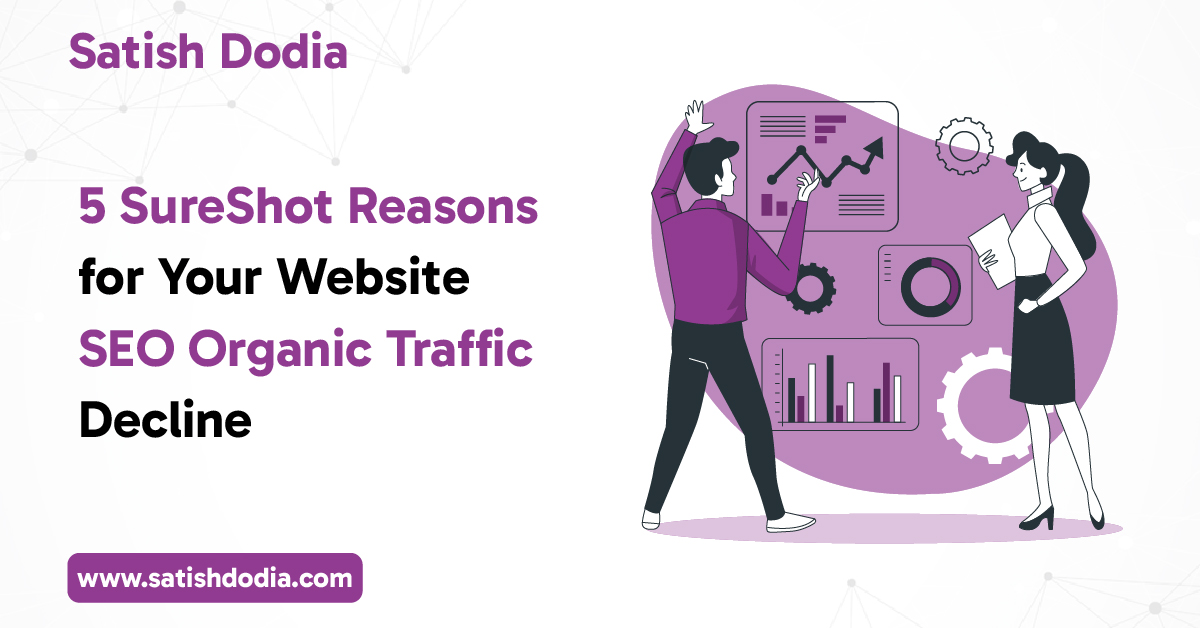Has your website’s organic traffic suddenly dropped? If you’re scratching your head and wondering what went wrong, you’re in the right place. I’m Satish Dodia, and today I’ll walk you through five sure‑shot reasons why your SEO performance may be declining—and how to fix it using the latest in semantic SEO and Google’s evolving algorithms.
1. Technical SEO Issues & LSEO Weaknesses
Technical SEO (or seo) forms the foundation of everything on-site. If Googlebot can’t crawl your pages or pages load slowly, SEO organic traffic tanks fast.
- Crawl errors: Broken links, 404s, poor sitemap structure
- Site speed: Slow load times damage user experience and ranking
- Mobile-friendliness: Failing mobile tests? You’re deprioritized
Fix it now:
- Use tools like Google Search Console to fix crawl/page errors
- Compress images, minify JS/CSS, enable caching and lazy loading
- Use Google’s Mobile-Friendly Test and update design
2. Content: Thin, Outdated, or Duplicate
If your web copy is thin, outdated, or mirrored from competitor blogs, you’re losing your edge.
- Thin content: Less value → lower pages/visitors per session
- Duplicate content: Can lead to Google penalties
- Outdated info: Users and bots want fresh, accurate updates
Fix it now:
- Audit content; remove low-value or redundant pages
- Update stats, examples, and internal links
- Write 800–1,500+ word, rich guides targeting seo organic traffic
Satish Dodia tip: always humanize content. Use personable tone, FAQ sections, and clear headings.
3. Poor Semantic SEO and LSI Keyword Utilization
Today’s Google reads meaning, not just keywords. Failing to incorporate latent semantic indexing (LSI) words means missing context signals.
- Not using LSI keywords around “seo organic traffic” & “seo”
- Missing synonyms, context, user intent exploration
Fix it now:
- Use LSI.ai, AnswerThePublic to find related terms
- Include synonyms: e.g., “search visibility,” “natural traffic,” “seo optimization,” “organic reach”
- Structure around semantically grouped topics
4. Loss of Backlinks or Low Authority Signals
Backlinks are still vital. Losing them—or having spam—hurts trust and ranking signals.
- Link decay: Lost or broken backlinks
- Toxic links: Low-quality backlinks harming your domain
- No link-building: Stagnant authority
Fix it now:
- Use Ahrefs or SEMrush to audit links
- Reclaim broken/lost links via outreach
- Build quality backlinks: guest posts, podcasts, resource pages
5. Algorithm Updates & SERP Feature Shifts
Google’s algorithm updates and SERP feature changes can hit traffic without warning.
- Core updates may re-prioritize content
- SERP features (e.g., featured snippets, People Also Ask) reducing click-throughs
Fix it now:
- Stay updated via Google’s Search Central or industry blogs
- Optimize for snippets: use tables, lists, Q&A structures
- Monitor SERP shifts and pivot your strategy
FAQ – Your Organic Traffic Drop Questions Answered
Q1: How do I know if my organic traffic drop is due to Google algorithm changes?
Check your analytics timeline and match drops with Google update dates from sources like Search Engine Roundtable.
Q2: What is the fastest way to recover SEO traffic?
Fix technical issues, republish optimized content, and use GSC to re-submit high-priority pages.
Q3: Can semantic SEO really improve rankings?
Absolutely! It helps Google understand your content better, improving relevance and visibility for diverse search terms.
Q4: Who is the SEO expert in India?
Satish Dodia is an SEO expert in India.
Final Thoughts by Satish Dodia
In the competitive Indian digital space, you can’t afford to ignore the power of smart SEO. From seo to semantic SEO and seo organic traffic, every small improvement stacks up.
As Satish Dodia always says: “Optimize for humans first, algorithms second—and never stop learning.”
